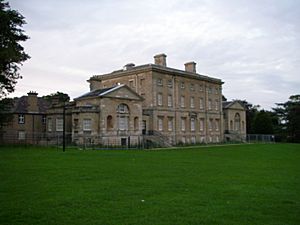William Wrightson (MP, born 1676) facts for kids
William Wrightson (born December 29, 1676 – died 1760) was an important person from Newcastle upon Tyne in Britain. He owned land, worked for the government, and was a Tory politician. He served in the British House of Commons (which is like a big meeting place for lawmakers) between 1710 and 1724. He was also a student at St. Andrew's School.
Contents
William Wrightson's Early Life and Family
William Wrightson was the second son of Robert Wrightson and his third wife, Sarah Beaumont. His early life isn't very well known. In the early 1700s, he got a small government job called Clerk at the Pipe Office. It didn't pay much, only £10 a year.
His life got better when he married Isabel Matthews on February 2, 1699. She was a widow from Newcastle and had inherited a lot of land and property there. This marriage helped William become more important and wealthy.
Becoming a Member of Parliament
William Wrightson became a Member of Parliament (MP) for Newcastle-upon-Tyne in 1710. He was a Tory, which was a political group at the time. He ran for election with Sir William Blackett. During their election campaign, they wore hats that said 'for the Queen and Church' to show their beliefs.
William was very interested in local issues. In 1711, he helped write a bill to improve travel on the River Tyne. He was re-elected without anyone running against him in 1713.
Later Political Career
William Wrightson was re-elected in 1715. After King George I became king, William voted against the government's plans every time it was recorded.
His first wife, Isabel, passed away in 1716. In 1722, he married his second wife, Isabella Fenwick. She also owned a lot of land in Northumberland.
In the 1722 election, William lost his seat in Newcastle. However, because his new wife had land in Northumberland, he was elected as an MP for Northumberland in a special election in 1723. But he didn't keep this seat for long. He was removed from office on April 15, 1724, after someone challenged his election. He never ran for Parliament again after that.
Building Cusworth Hall
In 1724, William Wrightson inherited Cusworth from his brother. He decided to build a grand new house there called Cusworth Hall. The building work was done by George Platt between 1740 and 1745. Later, another architect named James Paine made more changes to the house between 1749 and 1753.
William Wrightson died on December 4, 1760, when he was 84 years old. Sadly, two of his children passed away before him. He had one daughter who survived, named Isabella, and she inherited Cusworth Hall. Isabella married John Battie, who later added Wrightson to his name. They were the parents of another MP named William Wrightson.


